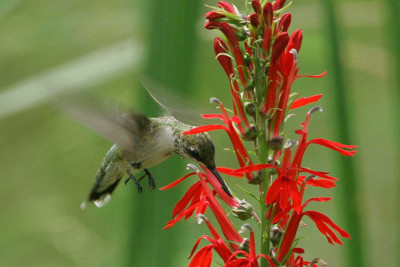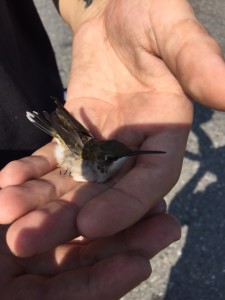Unless you are near a flowering garden or a nectar feeder, you will likely have a hard time catching sight of a hummingbird. Most hummingbirds zip around at high speeds, weaving skillfully through plants and going from garden to garden in search of their next meal. Able to maneuver around obstacles with deft precision, hummingbirds can come to a complete stop in an instant, fly backwards, sideways, and up and down, hover in mid air, and make minute adjustments to their position while feeding from a flower.

Their unique flying style, along with their long bill and specialized tongue, are what make hummingbirds particularly suited to getting hard to reach nectar out of tubular flowers. In fact, some scientists believe a number of plant species (up to 19 found in the Eastern United States) have co-evolved with hummingbirds. The Cardinal-flower, for example, with its long tubular flowers and lack of landing platform, seems ideally suited to the Ruby-throated Hummingbird. Any pollinator hoping to dine on a Cardinal-flower will have to hover for most of its meal, and few except the hummingbird can manage such a feat. Moreover, when the hummingbird inserts its bill into the flower, the top of its head is in exactly the right position to receive the plant’s pollen.
Although there are many types of hummingbirds (more than 300 species worldwide), the Ruby-throated Hummingbird is the the only hummingbird that breeds in Eastern North America, migrating from its wintering grounds in Mexico and Central America to Central and Eastern United States and Southern Canada. As part of their migration, Ruby-throated Hummingbirds cross the Gulf of Mexico in one nonstop flight, covering up to 500 miles in 18 to 22 hours. As soon as they touch down, they are immediately on the hunt for for food, which comes mainly in the form of nectar but can also include spiders, flies, gnats, aphids, and other small insects.
Although there are many types of hummingbirds (more than 300 species worldwide), the Ruby-throated Hummingbird is the the only hummingbird that breeds in Eastern North America, migrating from its wintering grounds in Mexico and Central America to Central and Eastern United States and Southern Canada. As part of their migration, Ruby-throated Hummingbirds cross the Gulf of Mexico in one nonstop flight, covering up to 500 miles in 18 to 22 hours. As soon as they touch down, they are immediately on the hunt for for food, which comes mainly in the form of nectar but can also include spiders, flies, gnats, aphids, and other small insects.
Since hummingbirds prefer to stay near dense areas of plant life where food is readily available, it is rare to see them in urban areas where there are more tall buildings than tall trees. However, following the sight and scent of an alluring flower, hummingbirds will occasionally wander into more congested areas and find themselves trapped in a house or building.

In August, City Wildlife was called about a hummingbird that had flown into a Safeway on Connecticut Avenue. After catching sight of the elaborate flower display in the foyer, the bird had gone to investigate and once inside, it could not figure out how to get back out. Two DC Animal Care and Control Officers (ACOs) were dispatched, and working together they were able to catch the bird and release it back into the wild. We are incredibly grateful for their efforts and happy they were able to rescue the bird before it was injured. Hummingbirds are particularly hard to rehabilitate so we try to intervene as little as possible.
The best way to support Ruby-throated Hummingbirds is to plant a variety of native plants and wildflowers in your garden such as: trumpet honeysuckle, scarlet beebalm, lemon beebalm, wild bergamot, cardinal flower, trumpet creeper, spotted jewelweed, red columbine, Canada lily, Indian pink, red buckeye, and mountain rosebay (also called catawba rhododendron).

No comments:
Post a Comment